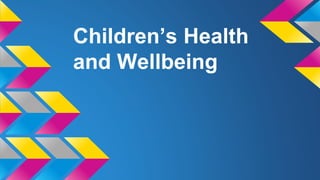
Children's health and wellbeing
- 1. Children’s Health and Wellbeing
- 2. Children’s well-being consists of ● Attachment ● Role of the key person ● Transitions and significant event ● Physical care needs ● Factors affecting health and well-being ● Local and national initiatives to promote health and well-being ● Working in partnership ● Food and nutrition ● Exercise
- 5. Key person
- 7. Attachment
- 8. Bowlby media clip Remember to make notes throughout this clip
- 9. Bowlby media clip 1)what attachment behaviour could be shown? 2)what did Bowlby say children were seeking other than to be fed? 3)what did Bowlby say about children’s outcomes?
- 10. Bowlby media clip 4) what type of attachment do parents and babies need to make? 4) what did the parent say impacted on her building attachment to her child?
- 11. Bowlby theory 6) who elses theory was used to prove the type of attachment that the mother had with her child? 7) what conditions could be apparent if children are not forming attachment with their parent/main carer?
- 12. Developing attachments Think, pair, share how you would advise parents and main carers to develop secure attachments.
- 13. The importance of attachment in your group you are going to research and present, explaining one of the following: ● the importance of attachment to a child’s emotional development ● factors impacting on attachment including reasons for separation following birth
- 14. The importance of attachment ● implications for attachment in relation to mothers health including post natal depression ● interruptions to the attachment process ● multiple attachment and Michael Rutter multiple attachment theory
- 15. The importance of attachment ● Harry Harlow and attachment theory ● James and Joyce Robertson and separation theory ● The socialisation process ● Emotional growth of children and how they manage their feelings, emotions and behaviour
- 17. In small groups Evaluate the importance of attachment for children’s development.
- 18. Key person’s role in relation to children’s emotional well-being
- 19. In your groups discuss; ● work in partnership with parents/carers and other professionals ● develop relationships with children ● record keeping and profile assessment tracking ● encourage and support children’s emotional well-being
- 20. What does the EYFS state? Look at your EYFS Statutory guidance what does this state about the role of the key person ?
- 21. Key Terminology independance resilience confidence self- reliance empowerment relationship building well-being
- 22. Analysis Independently analyse the impact of secure relationships on a child’s wellbeing.
- 23. Transition Think, pair, share different transitions and significant events that a child may experience.
- 24. Transitions and significant events ● moving to school ● starting and moving through day care ● birth of a sibling ● moving home ● living outside the home ● family breakdown ● loss of significant people
- 25. In groups Pick at least two transitions Discuss how the transitions can interrupt a child’s development and emotional well-being
- 26. Consider ● How an early years practitioner would prepare the child for the planned transition ● How an early years practitioner would support the child during the transition
- 28. Role of the early years practitioner for transitions ● prepare the child ● work in partnership with others ● identify needs of the child during transitions ● support the child during transitions ● Be aware of implications for child’s emotional health - key terminology
- 29. Physical needs of children ● rest and sleep ● fresh air ● food and water ● protection from injury/illness UNCHR
- 30. United Conventions for Rights of Child ● right to be with their family or who care best for them ● right to enough food and clean water ● right to health care ● right to be heard
- 31. In your group You are required to research your given area and produce a routine sheet and a checklist that everyone will be assessed against.
- 32. You are now able to begin your assessments for unit 2.